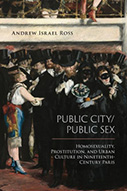Public City/Public Sex: Homosexuality, Prostitution, And Urban Culture In Nineteenth-Century Paris

Author: Andrew Israel Ross
Publisher: Philadelphia: Temple University Press, 2019. 286p.
Reviewer: Scott Turner | May 2021
Public City/Public Sex by Andrew I. Ross, is situated in nineteenth-century Paris. It was a period that was marked by economic revitalization and social and cultural transformation. Those markers link the author’s findings to contemporary society emphasizing the interplay in urban planning, policing, revitalization, and sexuality. The book reveals a myriad of strategies that were used by public and private planners during the period to redevelop Paris into a modern metropolis. It also revealed a delicate balance between social control and “men’s need” for sex in a civil society. On that latter point, the study offers some interesting clues to help explain the evolving nature of Parisian sexuality and sexual evolution in our own cities today.
The author guides the reader along a path that is etched in the historical record. That record includes documents from the National Archives of France and Paris, the courts, police reports, personal diaries, and more. From those pages, a rich history comes to light, including a detailed series of interactions, concerns, and attitudes from a vast community network. That network is composed of state administrators, police, moralists & entrepreneurs, sex workers, those who sought out sex, and others who encountered sex in public spaces during the period.
The network is a part of the story because within its nodes are the recordings of the interactions, attitudes, and decision making of its various parts. It is an interesting mix of stakeholders that includes madams, prostitutes, public administrators, police, business interests and moral entrepreneurs to name a few. This is quite a contrast from the professional and expert class that dominate our public discourse today. In Paris, there were many voices sharing influence over public policy and the future of the city. Ross bears that out as he unravels their stories and identifies the mechanisms that shape Parisian life and its many shades of glamour.
The central thesis in Public City, Public Sex rested on a series of propositions that were buttressed by revitalization and social control. Ross claimed that each time the Parisians redeveloped a section of their city, enhanced the public infrastructure, segregated the classes, or redesigned public spaces, commuting and consumerism expanded. In turn, new opportunities were created for women who sold sex to men and men who sought sex with other men. Which in turn triggered a new dimension of social control. This process is what Ross claimed was responsible for the nurturing and growth of two distinct sexual subcultures within the gay and lesbian community. He argued that these new cultures were of such a nature that anyone could belong to them or join – at least temporarily.
I reflected on the central thesis and concluded that it was one of the more insightful features of the book. Take Parisian’s efforts to control sex workers for example. Rather than arrest or prohibit sex workers from making a living, or interfering with men’s “need’ for sex, the industry was regulated as a lawful venture. Contrast that with the American model that outlaws sex rendering the practice and those who participate criminals. Both approaches seem to have a similar result; more opportunities for sex. Thus, there is logic to regulation and social control when it comes to sex work. In either case, though, opportunities for sex increase.
Ross’s discussion of the evolving subculture within the gay and lesbian community flowed from that logic. He argued that as subcultures in the gay and lesbian community expanded, opportunities to participate in those subcultures increased. It’s a simple enough idea, but Ross went on to claim that there was a nexus between those opportunities and sexual evolution. So, as opportunities for sex increased and sexual subcultures expanded, they also evolved. Although his findings were related to Parisian culture, I could not help but consider whether the same dynamics are at work today in other cities like New York, New Orleans, Los Angeles, or even Muncie Indiana. If so, what are the implications?
There was also some discussion about the patriarchal nature of Parisian culture in the study. That should not surprise anyone, considering that the study was situated in the nineteenth century. Those who sold sex, primarily women, were treated differently than those who bought sex, primarily men. It struck me that despite our differing attitudes on patriarchy, similar patterns exist in our own laws and in policing. So, here too, there seems to be a logic to how regulation and social control are carried out, then and now.
Overall, I found Ross’s ability to decipher the past insightful. At first glance, some law and criminal justice researchers might take a pass on a book about sexuality in nineteenth-century Paris, but there’s more than meets the eye in its pages. Indeed, I selected this book to review because I suspected that it would shed new insights on law, policing, social control, and sexuality and I was not disappointed. It was a sophisticated study that I would recommend to graduate level students and professionals. Upper-level sociology and criminal justice majors in undergraduate programs might also be well served reading it.
Scott Turner, Assistant Public Defender, Wayne County, New York


